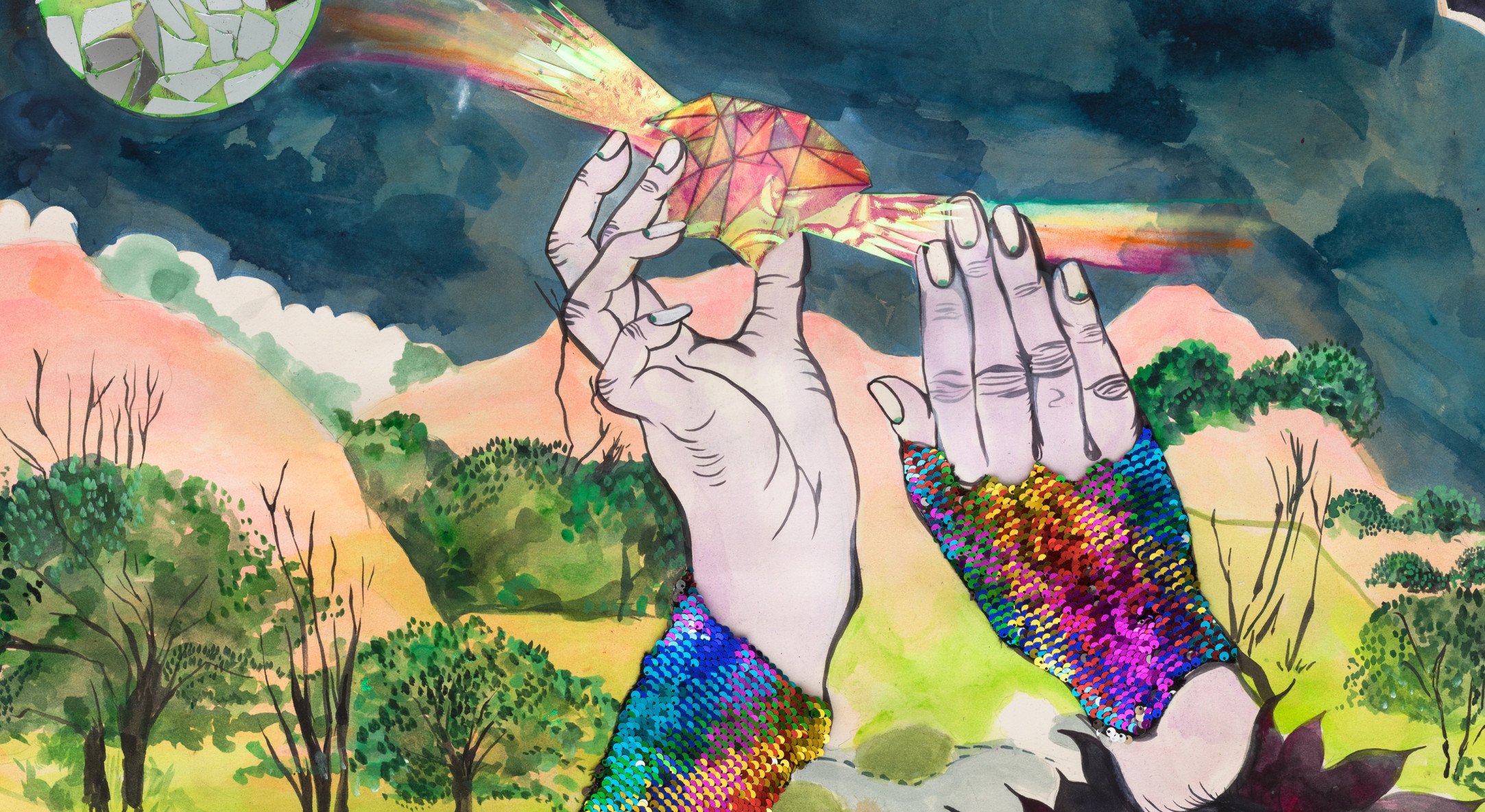
Nightswimmers, Hales Gallery, November 18 2021-February 5 2022
Hales is delighted to announce Nightswimmers, the gallery’s first solo exhibition of works by Chitra Ganesh.
Nightswimmers continues Ganesh’s immersive practice of kaleidoscopic experiments. In complex investigations of the social and physical body, she layers drawings, sculptural elements, and visual imagery with her own writing — an intricate process of intertwining different forms. Words dance across the surface in works such as Svati (Then & Now) and Mother, the sentences float as if protecting the luminous figures below. In poetic musings she is inspired by instances of opposition and dissent, often drawing from first person testimony as well as proverbs and protest songs, such as the phrase, ‘They tried to bury us, they didn’t know we were seeds.’ First noticing the slogan at protests against India's current government and its Hindu nationalist policies of targeted surveillance, the words have been notably linked to the ‘Families Belong Together’ campaign in the US — a response to government policy separating children from parents. Ganesh’s longstanding exploration of the language and aesthetic of political acts of resistance feeds into all the facets of her practice.
In these new works for Nightswimmers, Ganesh creates beautiful respite, weaving everyday life with the magical, speaking to quiet, playful moments of human connection. The erotic runs as a current through all of the pieces, as a great source of power and creative energy that is physical and psychic. Women are depicted nude and relaxed, lounging by water and swimming together, there is a spiritual grounding in nature. Their bodies are often in a state of becoming – heads turn into animals, trees and flowers, in mystical scenes full of fantastical elements. As well as whole figures, specific body parts are repeated in the works. These come from close readings of bodily movements, particularly of hand gestures and the many things they can symbolize, such as defiance, surrender, openness and care. Eyes repeat throughout the works to represent multiple realms of visibility and ways of seeing. There is an erotic connection to both the physical and spiritual body.
Exploring the transient nature of things, including states of mind and the body itself, Ganesh has long been fascinated by visual imagery that represents the liminal space between life and death. This theme emerged when developing her solo exhibition at the Rubin Museum, NY in 2018. Death Dancer (2021) continues this thread of her practice, depicting a guardian of the underworld, directly referencing the Citipati, a Tibetan deity, who symbolizes the eternal dance of death. Developing her own iconographies, she plays with archetypal subjects, such as the Vitruvian man, which becomes a three-breasted figure surrounded by rose petals.
In Mother (2021) a girl is surrounded by thought bubbles which repeat the words ‘Mother’ pronounced Amma in the Tamil language. This work was extracted from a longer comic-style piece made at the beginning of the pandemic, entitled Anima Mundi. In nonlinear narratives and richly layered visual worlds, Ganesh subverts traditional storytelling to create femme and queer-centric narratives. Each work, a moment in an epic, woven from everyday stories and everyday materials, draws the viewer into her alternate reality.

Ammammammammamma, 2021 Acrylic paint, porcelain, cowrie shells, glass and fabric on paper 142.1 x 119.9 x 5.2 cm

Death Dancer, 2021 Watercolor and tea on paper 184.2 x 142.2 x 5.9 cm

Untitled, 2021 Flowers, canvas, thread, paint, mica flakes and textile on paper 226.7 x 264 x 7.1 cm

Svati, Then & Now, 2021 beadwork, pastel, canvas, vinyl, cord and rose petals on paper 108 x 137.8 x 4.4 cm

Nightswimming, 2021 Watercolor, sequins, embroidery, ink,mirror, chalk, glitter and sand on paper 164.6 x 111.6 x 5.1 cm

Guardian, 2021 Ink, paint, fabric, pastel, paper, rope and tea on linen 121.9 x 152.4 cm

Open Expectations of the Unknown Event, 2021 Clay, brocade, chalk, paint, gouache, insulation material, vinyl, canvas and embroidery on paper 243.4 x 291.5 x 11.3 cm

we are the dust, 2021 Rope, embroidery, canvas, textiles, handmade paper, acrylic and ink on paper 189.2 x 112.1 x 4.1 cm

The Five Sisters (Amma/Akka. Sita, Meena, Jaya, Gita), 2021 Mirror, leather, glass, chalk, fabric, wood, clay and cord on paper 167.2 x 114.1 x 11.3 cm

Vitruvian Flight, 2021 Paint, rose petals and embroidery on paper 54.3 x 39.1 x 3.8 cm

at any moment, 2021 Mixed media and acrylic on canvas

Untitled, 2021 Ink and rose petals on paper 54.3 x 39.1 x 3.8 cm

